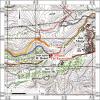Vertical tabs
In the 1985-86 excavations a W-E hall delineated on the north and south by two late thick walls and on the east by a much thinner wall were uncovered. The hall was decorated by two mosaic carpets and a 3 lines long Greek inscription. Another mosaic paved hall was partially uncovered 2m to the north. Storchan and Albag (2021) suggested that this was a monoapsidal church with a hall attached on the north. The western carpet of the prayer hall is earlier than the eastern one, and the Greek inscription, set at its eastern edge, seems to be still later (written partially on the edge of the carpet), or contemporary with it. The building inscription (see under Epigraphy), dated epigraphically to the end of the 6th century (April 594), or early in the 7th century (April 609), seems to denote a late refurbishing of a pre-existing church. It was suggested that the northern hall was the diakonikon mentioned in the inscription (or a baptistery). In the 2015 and 2016 seasons an area immediately beyond the late, eastern wall was excavated. A subterranean burial chamber (2.4x2.6m; 1.4m high), accessed by two sets of four stairs descending from east to west was uncovered there. It might had held a coffin, or two troughs. According to Storchan and Albag it was accessed from the outside, from the east of the apse. One of the stone slabs that had covered the narrow staircase leading to the crypt was still preserved in situ. The tomb was located in a N-S hall roofed by two arches.
An entrance with a threshold in the south marks the entrance from the bema to the southern aisle, where traces of a mosaic floor were also discerned. Storchan and Albag suggested to trace in one of the photos the course of the apse (mentioned as well in the inscription), The central location of the crypt in the eastern part of the building suggest that we have to do here with a memorial chapel and that the church was a pilgrims church, as is suggested by the Arabic name of the site - Khirbet el Khan.
In the 1990's surveys several cisterns, a vast winepress and other installation as well as a rock-cut pool were recorded. The winepress was excavated in the 2015-2016 seasons. The fact that the church was a component of a larger architectural complex that includes the winepress suggest a monastery that also served as a road station. A building located to the north of the chapel might had served as a hospice (see sitemap)
The Byzantine walls flanking the nave from the north and from the south were incorporated into the later, Ayyubid, structure.
4.9m wide. Two mosaic carpets decorating the nave were uncovered. At the eastern edge of the eastern carpet, presumably in front of the bema with the underlying crypt, a 3 lines long Greek inscription was found. It mentions several architectural components: a prostheke, an apse (konche), a diakonikon, and the refurbishing in paintings and revetment of the end wall of the presbitery. The prostheke may refer to the underground tomb (theke), rather than to the nave.
Storchan and Albag observed the bases of five piers to the south of the nave, and three to its north separating it from the two aisles that did not survived. The intercolumniation is 1.5m. According to them the aisles were dead-end.
According to the reconstruction of Storchan and Albag, the burial crypt accessed from the outside, was located beneath the bema. A well cut corner of ashlars located farther to the east of the apse may mark the north-western corner of an elaborate entrance to the crypt. This corner is attached to the eastern pier of a northern roofing arch. The bottom course of two other piers were still preserved on either side of the western wall of this space. These piers carried two arches that had supported a flat roof. No remains of a chancel screen were preserved. Several architectural members (bases and pilaster capitals) of a small order, might had belonged to a canopy that had adorned the altar and the underlying crypt.
The elevation of the single slab serving as a roof of the staircase leading down to the crypt, and that of the sill of the southern room, mark the elevation of the bema floor, being, of course, higher than the level of the mosaic floor to its west. A mosaic patch at an higher elevation indicates that the bema was mosaic paved.
On the NW two square stones, seemingly for supporting two legs of an ambo were incorporated in the mosaic floor.
According to Storchan and Albag the aisles were dead-end, so there were no pastophoria.
| Total |
|---|
5 |
6th century, acording to the patterns of the western carpet. In any case, this phase predate the eastern mosaic carpet and the Greek inscription on its eastern edge mark the second phase of refurbishing.
The inscription, dated according to the indiction and the month, and according to its paleography, is attributed to April 609 CE, rather than April 594 (Di Segni 2003). The diakonikon, mentioned in the inscription, is also of this phase.
Iconoclastic activity evident in the mosaic floors of the prayer hall, indicates that the church continued to be in use until after the first quarter of the 8th c. It was abandoned thereafter. Perhaps in the later part of the 8th c. The almost absolute lack of the finds from the Byzantine period led the excavators to suggest that the church was abandoned before the earthquake of 749, which destroyed the building. In the Ayyubid and Mameluke periods the site served as a road station (Khan).














